

Ross Hoddinott/NaturePL

Ross Hoddinott/NaturePL
Sut i adeiladu pwll dŵr
It is thought that some amphibians, such as frogs, are now more common in garden ponds than in the countryside. You can build a pond at any time during the year, but if you start in autumn or late winter, it will get established much quicker.
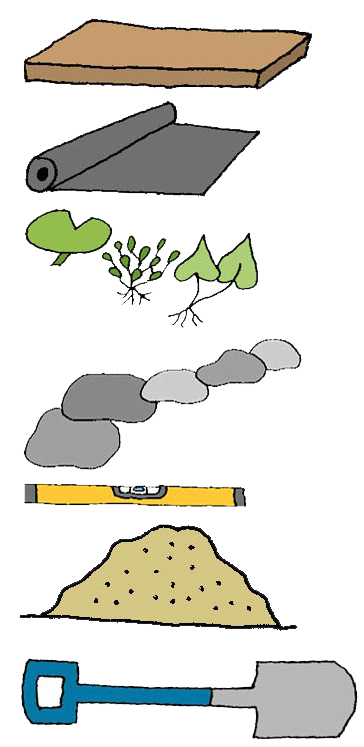
You will need:
A big patch of garden
A plank of wood
Pond liner - preferably made of butyl rubber, which is durable, flexible, moderately cheap and easy to work with
A variety of pond plants
Some large rocks
A spirit level
Builder's sand
A good spade or mini-digger depending on how big your pond will be.
Water (use rainwater for best results)
How to build your pond
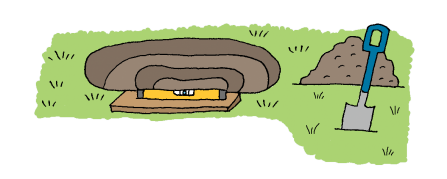
Step 1
It is better for wildlife if you put the pond in a warm, sunny area – tadpoles, dragonflies and plants with thrive in these conditions. First, mark out your pond on the ground with a rope or hosepipe, and then get digging! Ensure that the sides are level as you dig by placing a plank across the pond’s hole with a spirit level on top. Remember to include some shallow areas in your pond.
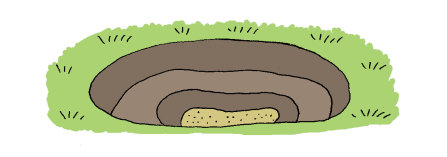
Step 2
Remove any sharp stones from the bottom of the hole. Put down a 5 cm-thick layer of sand to line the hole. Sand is preferable because it is sterile and will not harbour any undesirable seeds or microbes, but you can also try old carpet, newspapers or even loft insulation material. Remember to save some sand for step 4.
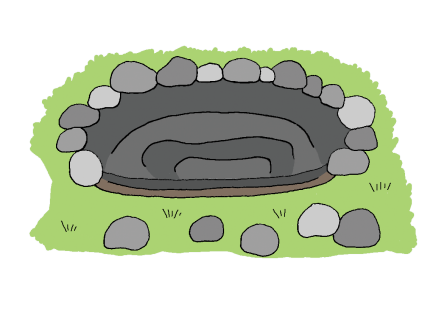
Step 3
Dig a trench around the edge of the pond for the overhanging pond liner to drop into. Place the liner carefully in the hole and tuck the edge into the trench; weigh it down with large rocks. Any extra excess liner can be snipped off with scissors.
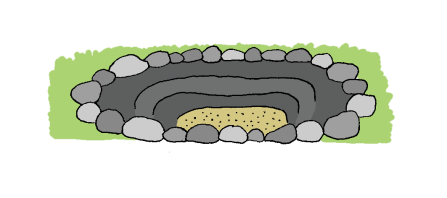
Step 4
Fill the bottom of the pond with the remaining sand.
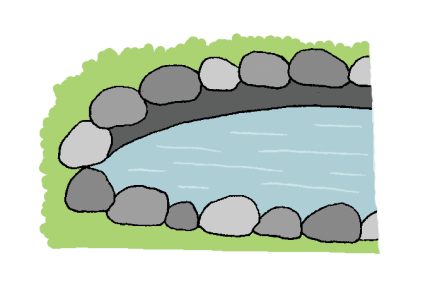
Step 5
Fill the pond up, this may take longer than you think. If possible, use collected rainwater to fill your pond, or fill from the tap with a hose. To stop the sand substrate dispersing, rest the nozzle of the hose on a plastic bag to absorb some of the energy. If you do fill your pond with tap water then leave it so stand for a few days before adding it in.
As the pond fills up, the liner will stretch. Back fill the trench around the edge of the pond with soil. As the pond is filling, place turf, soil or flagstones over the exposed liner at the pond edges. Butyl liner degrades in sunlight, so try not to leave areas of uncovered liner exposed for too long.

Step 6
Plants can be introduced to your pond approximately 1-2 weeks after the initial filling with water. Carefully selected native species (see below) will support your local wildlife.
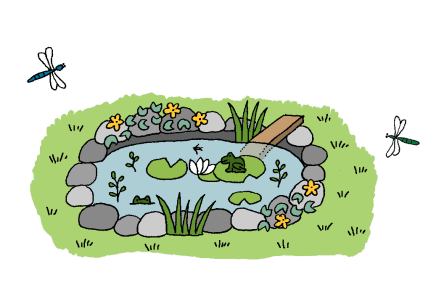
Step 7
Watch and see what wildlife visits. Place stones, logs and plants around the edges to create habitats for pond-visiting creatures. Consider adding a plank of wood to help any wildlife that might fall in.
If plants are well chosen, and the pond is kept in a relatively balanced ecological state, it shouldn’t need much maintenance at all. However, do keep an eye out for a build-up of dead organic matter and encroaching vegetation.
Choosing your pond plants
There are four 'zones' in which pond plants may be grown; try to have plants in each zone.
1) Totally submerged (in deeper water) - oxygenating plants
- Spiked Water-milfoil - Myriophyllum spicatum
- Hornwort - Ceratophyllym demersum (pollution intolerant)
- Shining Pondweed - Potamogeton lucens
- Horned Pondweed - Zannichellia palustris
- Fennel Pondweed - Potamogeton pectinatus (pollution tolerant)
- Water Starwort - Callitriche stagnalis (pollution intolerant)
2) Submerged but with floating leaves (also in deep water) - oxygenating plants
- Water Crowfoot/Buttercup - Ranunculus aquatilis (pollution intolerant)
- Bladderwort - Urticularia spp
- Frogbit - Hydrocharis morsus-ranae
- Broad-leaved Pondweed - Potamogeton natans (pollution tolerant)
- Curled Pondweed - Potamogeton crispus (pollution tolerant)
3) Emergent (in shallower area)
- Branched bur-reed - Sparganium erectum (tall, can be invasive)
- Amphibious bistort - Persicaria amphibium
- Arrowhead - Sagittaria aquatilis
- Water crowfoot - Ranunculus aquatilis
- Water mint - Mentha aquatica (can be invasive, strong scent deters some insects)
- Flowering rush - Butomus umbellatus
- Water plantain - Alisma plantago-quuatica (tall)
- Water forget-me-not - Myosotis scorpiodes
- Marsh cinquefoil - Potentilla palustris
- Greater pond-sedge - Carex riparia (sedges and grasses are good for pond invertebrates)
4) Marginal (growing in the pond edge and bog areas)
- Flowering Rush - Butomus umbellatus
- Lady's Smock - Cardamine pratensis
- Marsh Marigold - Caltha palustris
- Purple Loosestrife - Lythrum salicaria (tall, good for bees)
- Gipsywort - Lycopus europaeus
- Meadowsweet - Filipendula ulmaria (tall, good for birds in autumn)
- Brooklime - Veronica beccabunga
- Ragged-Robin - Lychnis flos-cuculi
- Soft Rush - Juncus effusus
- Water Forget-me-not - Myosotis scorpioides
- Bungle - Ajuga reptans
- Water Avens - Geum rivale (spreading)
- Marsh Woundwort - Stachys palustris (tall)
- Great Willowherb - Epilobium hirsutum (tall)
- Hemp Agrimony - Eupatorium cannabinum (tall)
- Fleabane - Pulicaria dysenterica
- Creeping Bent - Agrostis stolonifera
- Marsh Foxtail - Alopecurus geniculatus
- Fool's Watercress - Apium nodiflorum
- Common Spike-rush- Eleocharis palustris
- Water Pepper - Persicaria hydropiper
- Silverweed - Potentilla anserina
- Creeping Jenny - Lysimachia nummularia (low-growing ground cover)
- Water Dock - Rumex hydrolapathum (can be invasive)
